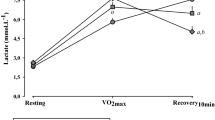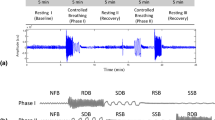Abstract
Investigation of the interaction between cardiovascular variables and respiration provides a quantitative and noninvasive approach to assess the autonomic control of cardiovascular function. The aim of this paper is to investigate the changes of cardiopulmonary coupling (CPC), blood pressure (BP) and pulse transit time (PTT) during a stepwise-paced breathing (SPB) procedure (spontaneous breathing followed by paced breathing at 14, 12.5, 11, 9.5, 8 and 7 breaths per minute, 3 min each) and gain insights into the characteristics of slow breathing exercises. RR interval, respiration, BP and PTT are collected during the SPB procedure (48 healthy subjects, 27 ± 6 years). CPC is assessed through investigating both the phase and amplitude dynamics between the respiration-induced components from RR interval and respiration by the approach of ensemble empirical mode decomposition. It was found that even though the phase synchronization and amplitude oscillation of CPC were both enhanced by the SPB procedure, phase coupling does not increase monotonically along with the amplitude oscillation during the whole procedure. Meanwhile, BP was reduced significantly by the SPB procedure (SBP: from 122.0 ± 13.4 to 114.2 ± 14.9 mmHg, p < 0.001, DBP: from 82.2 ± 8.6 to 77.0 ± 9.8 mmHg, p < 0.001, PTT: from 172.8 ± 20.1 to 176.8 ± 19.2 ms, p < 0.001). Our results demonstrate that the SPB procedure can reduce BP and lengthen PTT significantly. Compared with amplitude dynamics, phase dynamics is a different marker for CPC analysis in reflecting cardiorespiratory coherence during slow breathing exercise. Our study provides a methodology to practice slow breathing exercise, including the setting of target breathing rate, change of CPC and the importance of regular breathing. The applications and usability of the study results have also been discussed.








Similar content being viewed by others
References
Altena MR, Kleefstra N, Logtenberg SJ, Groenier KH, Houweling ST, Bilo HJ (2009) Effect of device-guided breathing exercises on blood pressure in patients with hypertension: a randomized controlled trial. Blood Press 18:273–279. doi:10.3109/08037050903272925
Anderson DE, McNeely JD, Windham BG (2010) Regular slow-breathing exercise effects on blood pressure and breathing patterns at rest. J Hum Hypertens 24:807–813. doi:10.1038/Jhh.2010.18
Bahraminasab A, Kenwright D, Stefanovska A, Ghasemi F, McClintock PV (2008) Phase coupling in the cardiorespiratory interaction. IET Syst Biol 2:48–54. doi:10.1049/iet-syb:20060087
Bartsch RP, Schumann AY, Kantelhardt JW, Penzel T, Ivanov PC (2012) Phase transitions in physiologic coupling. Proc Natl Acad Sci USA 109:10181–10186
Berntson GG, Cacioppo JT, Binkley PF, Uchino BN, Quigley KS, Fieldstone A (1994) Autonomic cardiac control. III. Psychological stress and cardiac response in autonomic space as revealed by pharmacological blockades. Psychophysiology 31:599–608
Cysarz D, Bussing A (2005) Cardiorespiratory synchronization during Zen meditation. Eur J Appl Physiol 95:88–95. doi:10.1007/s00421-005-1379-3
Gabor D (1946) Theory of communication. J Inst Elect Eng 93:429–457
Drinnan MJ, Allen J, Murray A (2001) Relation between heart rate and pulse transit time during paced respiration. Physiol Meas 22:425–432
Eckberg DL (2003) The human respiratory gate. J Physiol 548:339–352. doi:10.1113/jphysiol.2002.037192
Gesche H, Grosskurth D, Kuchler G, Patzak A (2012) Continuous blood pressure measurement by using the pulse transit time: comparison to a cuff-based method. Eur J Appl Physiol 112:309–315. doi:10.1007/s00421-011-1983-3
Hamilton PS, Tompkins WJ (1986) Quantitative investigation of QRS detection rules using the MIT/BIH arrhythmia database. IEEE Trans Biomed Eng 33:1157–1165. doi:10.1109/Tbme.1986.325695
Hoyer D, Bauer R, Walter B, Zwiener U (1998) Estimation of nonlinear couplings on the basis of complexity and predictability—a new method applied to cardiorespiratory coordination. IEEE Trans Biomed Eng 45:545–552. doi:10.1109/10.668739
Huang NEWM, Long SR, Shen SS, Qu WD, Gloersen P et al (1998) The empirical mode decomposition and the Hilbert spectrum for nonlinear and non-stationary time series analysis. Proc R Soc Lond A 454:903–993
Joseph CN, Porta C, Casucci G, Casiraghi N, Maffeis M, Rossi M, Bernardi L (2005) Slow breathing improves arterial baroreflex sensitivity and decreases blood pressure in essential hypertension. Hypertension 46:714–718. doi:10.1161/01.HYP.0000179581.68566.7d
Kobayashi H (2009) Does paced breathing improve the reproducibility of heart rate variability measurements? J Physiol Anthropol 28:225–230
Landman GW, van Hateren KJ, van Dijk PR, Logtenberg SJ, Houweling ST, Groenier KH, Bilo HJ, Kleefstra N (2014) Efficacy of device-guided breathing for hypertension in blinded, randomized, active-controlled trials: a meta-analysis of individual patient data. JAMA Intern Med 174:1815–1821. doi:10.1001/jamainternmed.2014.4336
Lehrer PM, Gevirtz R (2014) Heart rate variability biofeedback: how and why does it work? Front Psychol 5:756
Lehrer PM, Vaschillo E, Vaschillo B, Lu SE, Eckberg DL, Edelberg R, Shih WJ, Lin Y, Kuusela TA, Tahvanainen KUO, Hamer RM (2003) Heart rate variability biofeedback increases baroreflex gain and peak expiratory flow. Psychosom Med 65:796–805. doi:10.1097/01.Psy.0000089200.81962.19
Logtenberg SJ, Kleefstra N, Houweling ST, Groenier KH, Bilo HJ (2007) Effect of device-guided breathing exercises on blood pressure in hypertensive patients with type 2 diabetes mellitus: a randomized controlled trial. J Hypertens 25:241–246. doi:10.1097/HJH.0b013e32801040d5
Lopes TC, Beda A, Granja-Filho PC, Jandre FC, Giannella-Neto A (2011) Cardio-respiratory interactions and relocation of heartbeats within the respiratory cycle during spontaneous and paced breathing. Physiol Meas 32:1389–1401. doi:10.1088/0967-3334/32/9/003
Mahtani KR, Nunan D, Heneghan CJ (2012) Device-guided breathing exercises in the control of human blood pressure: systematic review and meta-analysis. J Hypertens 30:852–860. doi:10.1097/HJH.0b013e3283520077
Mukkamala R, Hahn JO, Inan OT, Mestha LK, Kim CS, Toreyin H, Kyal S (2015) Toward ubiquitous blood pressure monitoring via pulse transit time: theory and practice. IEEE Trans Biomed Eng 62:1879–1901. doi:10.1109/TBME.2015.2441951
Wu Z, Huang NE (2009) Ensemble empirical mode decomposition: a noise-assisted data analysis method. Adv Adapt Data Anal 1:1–41
Novak V, Yang AC, Lepicovsky L, Goldberger AL, Lipsitz LA, Peng CK (2004) Multimodal pressure-flow method to assess dynamics of cerebral autoregulation in stroke and hypertension. Biomed Eng Online 3:39. doi:10.1186/1475-925X-3-39
Pagani M, Lombardi F, Guzzetti S, Rimoldi O, Furlan R, Pizzinelli P, Sandrone G, Malfatto G, Dell’Orto S, Piccaluga E et al (1986) Power spectral analysis of heart rate and arterial pressure variabilities as a marker of sympatho-vagal interaction in man and conscious dog. Circ Res 59:178–193
Pereda E, De la Cruz DM, De Vera L, Gonzalez JJ (2005) Comparing generalized and phase synchronization in cardiovascular and cardiorespiratory signals. IEEE Trans Biomed Eng 52:578–583. doi:10.1109/TBME.2005.844022
Piepoli M, Sleight P, Leuzzi S, Valle F, Spadacini G, Passino C, Johnston J, Bernardi L (1997) Origin of respiratory sinus arrhythmia in conscious humans. An important role for arterial carotid baroreceptors. Circulation 95:1813–1821
Pinna GD, Maestri R, La Rovere MT, Gobbi E, Fanfulla F (2006) Effect of paced breathing on ventilatory and cardiovascular variability parameters during short-term investigations of autonomic function. Am J Physiol Heart Circ Physiol 290:H424–H433. doi:10.1152/ajpheart.00438.2005
Rosenblum MG, Cimponeriu L, Bezerianos A, Patzak A, Mrowka R (2002) Identification of coupling direction: application to cardiorespiratory interaction. Phys Rev E Stat Nonlinear Soft Matter Phys 65:041909
Schachinger H, Weinbacher M, Kiss A, Ritz R, Langewitz W (2001) Cardiovascular indices of peripheral and central sympathetic activation. Psychosom Med 63:788–796
Schafer C, Rosenblum MG, Kurths J, Abel HH (1998) Heartbeat synchronized with ventilation. Nature 392:239–240
Schein MH, Gavish B, Herz M, Rosner-Kahana D, Naveh P, Knishkowy B, Zlotnikov E, Ben-Zvi N, Melmed RN (2001) Treating hypertension with a device that slows and regularises breathing: a randomised, double-blind controlled study. J Hum Hypertens 15:271–278. doi:10.1038/sj.jhh.1001148
Schulz S, Adochiei FC, Edu IR, Schroeder R, Costin H, Bar KJ, Voss A (2013) Cardiovascular and cardiorespiratory coupling analyses: a review. Philos Trans A Math Phys Eng Sci 371:20120191. doi:10.1098/rsta.2012.0191
Sharma M, Frishman WH, Gandhi K (2011) RESPeRATE: nonpharmacological treatment of hypertension. Cardiol Rev 19:47–51. doi:10.1097/CRD.0b013e3181fc1ae6
Shields RW Jr (2009) Heart rate variability with deep breathing as a clinical test of cardiovagal function. Clevel Clin J Med 76(Suppl 2):S37–S40. doi:10.3949/ccjm.76.s2.08
Sin PY, Galletly DC, Tzeng YC (2010) Influence of breathing frequency on the pattern of respiratory sinus arrhythmia and blood pressure: old questions revisited. Am J Physiol Heart Circ Physiol 298:H1588–H1599. doi:10.1152/ajpheart.00036.2010
Sood R, Sood A, Wolf SL, Linquist BM, Liu H, Sloan JA, Satele DV, Loprinzi CL, Barton DL (2013) Paced breathing compared with usual breathing for hot flashes. Menopause 20:179–184. doi:10.1097/gme.0b013e31826934b6
Task Force of the European Society of Cardiology and the North American Society of Pacing and Electrophysiology (1996) Heart rate variability: standards of measurement, physiological interpretation and clinical use. Circulation 93:1043–1065
Trunkvalterova Z, Javorka M, Tonhajzerova I, Javorkova J, Lazarova Z, Javorka K, Baumert M (2008) Reduced short-term complexity of heart rate and blood pressure dynamics in patients with diabetes mellitus type 1: multiscale entropy analysis. Physiol Meas 29:817–828. doi:10.1088/0967-3334/29/7/010
Voss A, Schulz S, Schroeder R, Baumert M, Caminal P (2009) Methods derived from nonlinear dynamics for analysing heart rate variability. Philos Trans A Math Phys Eng Sci 367:277–296. doi:10.1098/rsta.2008.0232
Wong MYM, Pickwell-MacPherson E, Zhang YT, Cheng JCY (2011) The effects of pre-ejection period on post-exercise systolic blood pressure estimation using the pulse arrival time technique. Eur J Appl Physiol 111:135–144. doi:10.1007/s00421-010-1626-0
Wu MC, Hu CK (2006) Empirical mode decomposition and synchrogram approach to cardiorespiratory synchronization. Phys Rev E Stat Nonlinear Soft Matter Phys 73:051917
Xu L, Chen Z, Hu K, Stanley HE, Ivanov P (2006) Spurious detection of phase synchronization in coupled nonlinear oscillators. Phys Rev E Stat Nonlinear Soft Matter Phys 73:065201
Acknowledgments
This project was supported in part by the Natural Science Foundation of China (Grant Number: 61471398), Beijing Natural Science Foundation (Grant Number: 3122034), General Logistics Science Foundation (Grant Number: CWS11C108) and National Key Technology Research and Development Program (Grant Numbers: 2013BAI03B04, 2013BAI03B05).
Author information
Authors and Affiliations
Corresponding author
Ethics declarations
Conflict of interest
The authors declare that they have no conflict of interest.
Rights and permissions
About this article
Cite this article
Zhang, Z., Wang, B., Wu, H. et al. Effects of slow and regular breathing exercise on cardiopulmonary coupling and blood pressure. Med Biol Eng Comput 55, 327–341 (2017). https://doi.org/10.1007/s11517-016-1517-6
Received:
Accepted:
Published:
Issue Date:
DOI: https://doi.org/10.1007/s11517-016-1517-6




